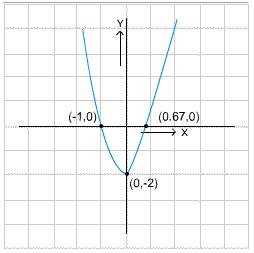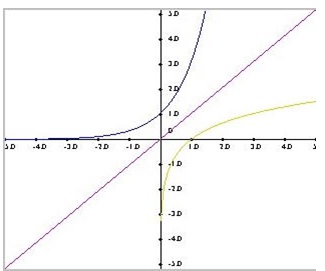Questions:
1A: Applications of Linear Equations
- Joe has a collection of nickels and dimes that is worth $5.65. If the number of dimes were doubled and the number of nickels were increased by 8, the value of the coins would be $10.45. How many dimes does he have?
- An express and local train leave Gray's Lake at 3 P.M. and head for Chicago 50 miles away. The express travels twice as fast as the local, and arrives 1 hour ahead of it. Find the speed of each train.
- Walt made an extra $9000 last year from a part-time job. He invested part of the money at 9% and the rest at 8%. He made a total of $770 in interest. How much was invested at 8%?
1B: Discussion Questions
1. How many solutions exist for a quadratic equation? How do we determine whether the solutions are real or complex?
2. What three techniques can be used to solve a quadratic equation? Demonstrate these techniques on the equation "12x2 - 10x - 42 = 0".

3. Look at the graph above and comment on the sign of D or the discriminant. Form the quadratic equation based on the information provided and find its solution.
4. Translate the following into a quadratic equation, and solve it: The length of a rectangular garden is three times its width; if the area of the garden is 75 square meters, what are its dimensions?
1C: Solutions of Quadratic Equations and their Applications
- Determine whether the following equations have a solution or not? Justify your answer.
a)x2 + 6x - 7 = 0
b)z2 + z + 1 = 0
c)(3)1/2y2 - 4y - 7(3)1/2 = 0
d)2x2 - 10x + 25 = 0
e)2x2 - 6x + 5 = 0
f) s2 - 4s + 4 = 0
g)5/6x2 - 7x - 6/5 = 0
h)7a2 + 8a + 2 = 0
- If x = 1 and x = -8, then form a quadratic equation.
- What type of solution do you get for quadratic equations where D < 0? Give reasons for your answer. Also provide an example of such a quadratic equation and find the solution of the equation.
- Create a real-life situation that fits into the equation (x + 4)(x - 7) = 0 and express the situation as the same equation.
1D: Practical Application of Quadratic Equations
- A rectangular garden has dimensions of 18 feet by 13 feet. A gravel path of uniform width is to be built around the garden. How wide can the path be if there is enough gravel for 516 square feet?
- A business invests $10,000 in a savings account for two years. At the beginning of the second year, an additional $3500 is invested. At the end of the second year, the account balance is $15,569.75. What was the annual interest rate?
- Steve traveled 200 miles at a certain speed. Had he gone 10mph faster, the trip would have taken 1 hour less. Find the speed of his vehicle.
- The Hudson River flows at a rate of 3 miles per hour. A patrol boat travels 60 miles upriver, and returns in a total time of 9 hours. What is the speed of the boat in still water?
1E: Discussion Questions - 5(1B)
-
- Do exponential functions only model phenomena that grow, or can they also model phenomena that decay? Explain what is different in the form of the function in each case.
- True or false: The function "f(x) = 3x" grows three times faster than the function "g(x) = x". Explain.
- What are the asymptotes of the functions "f(x) = 3x" and "g(x) = log52x"?
4. A cell divides into two identical copies every 4 minutes. How many cells will exist after 3 hours?
5. The level of thorium in a sample decreases by a factor of one-half every 4.2 million years. A meteorite is discovered to have only 7.6% of its original thorium remaining. How old is the meteorite?
1F: Assignment 3: Graphs of Exponential and Logarithmic Functions
Refer to the graph given below and identify the graph that represents the corresponding function. Justify your answer.
y = 3x
y = log3x

Plot the graphs of the following functions. Scan the graphs and post them to the Facilitator along with your response.
1. f(x)=7x
2. f(x)=4x - 3
3. f(x)=(1/5)x
4. f(x)= log3x
1G: Discussion Questions
- Give an example of an exponential function. Convert this exponential function to a logarithmic function. Plot the graph of both the functions and post to the discussion forum. Discuss these functions and their graphs with your classmates.
- Form each of the following:
- A linear equation in one variable
- A linear equation in two variables
- A quadratic equation
- A polynomial of three terms
- An exponential function
- A logarithmic function
- Plot the graph of the above equations formed in question 2, and post your response to the discussion forum.
- Derive the quadratic and linear equations from the corresponding graphs of a classmate.

Plot the graphs of the following functions. Scan the graphs and post them to the Facilitator along with your response.
1 f(x)=7x
2(x)=4x - 3
3(x)=(1/5)x
4(x)= log3x
1H: Evaluate Functions
Evaluate the functions for the values of x given as 1, 2, 4, 8, and 16. Describe the differences in the rate at which each function changes with increasing values of x.
- f(x) = 5x - 3
- f(x) = x2 - 3x + 2
- f(x) = 2x3 + 7x2 - x - 1
- f(x) = 10x
- f(x) = ln x